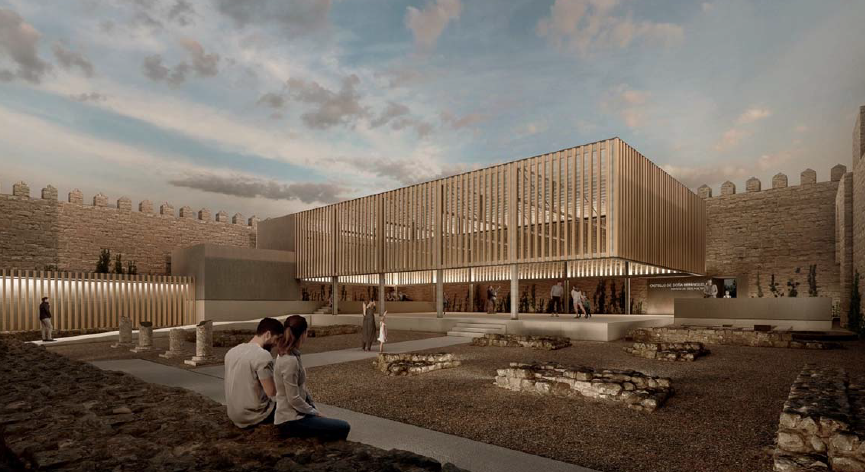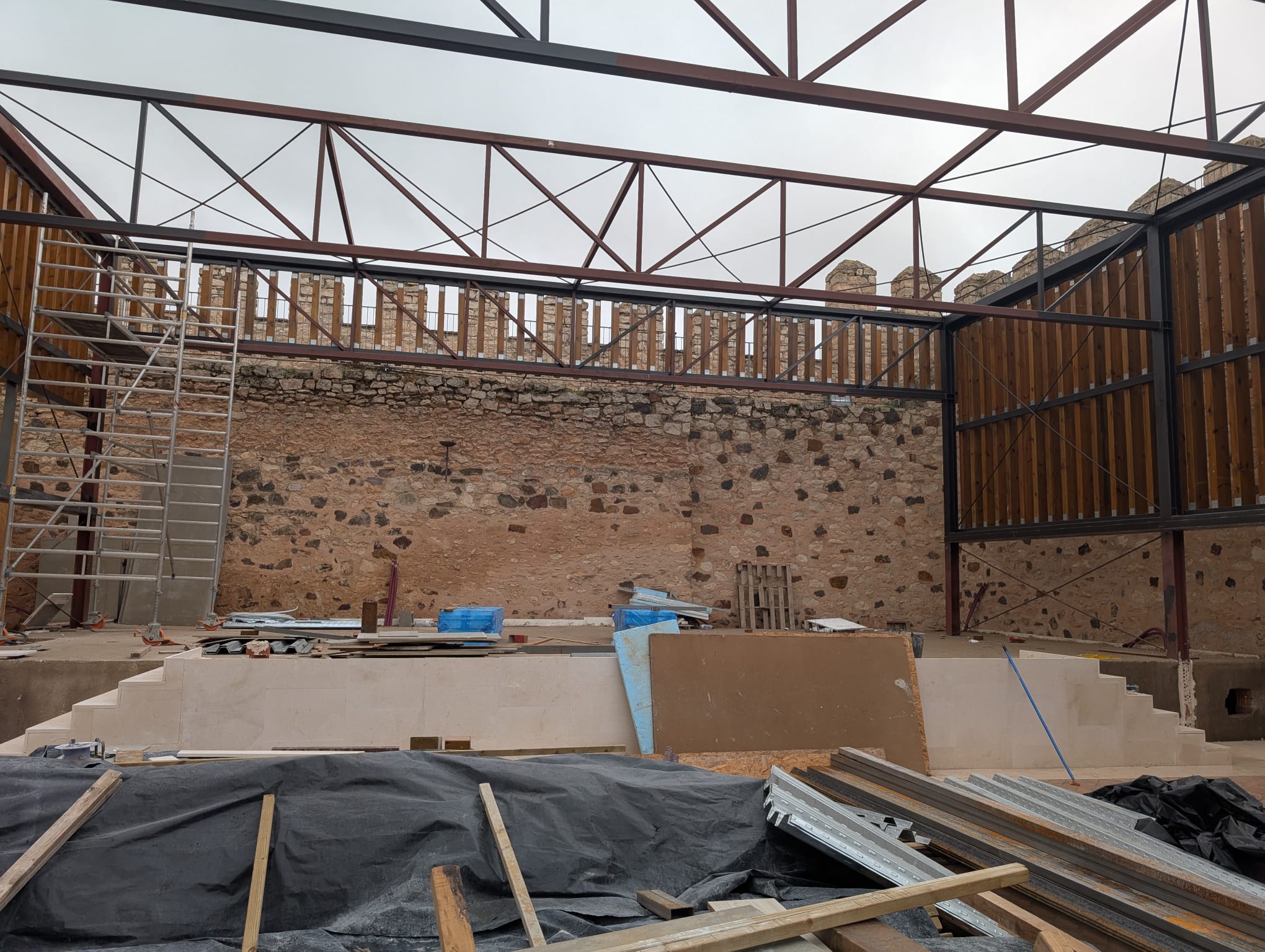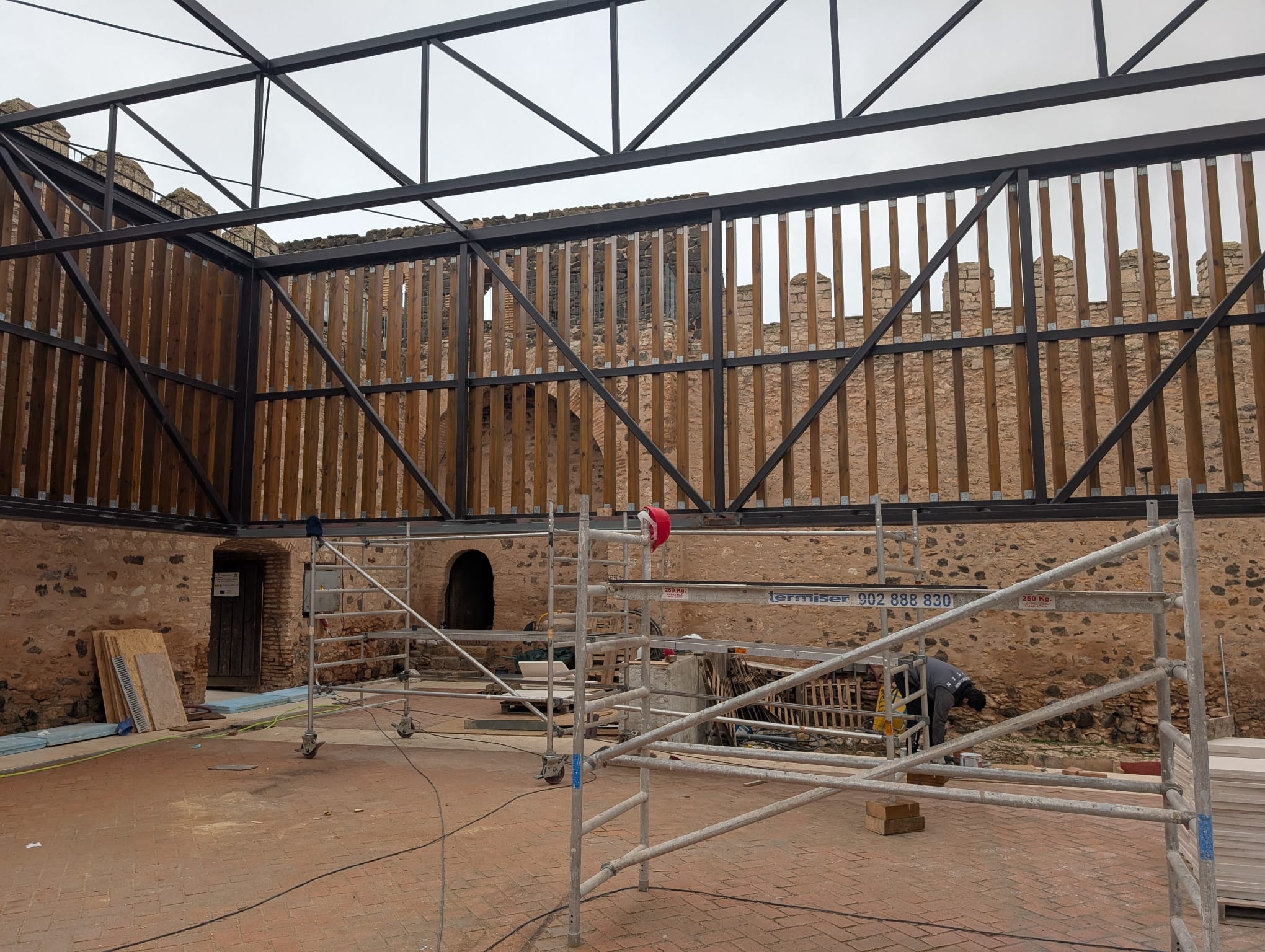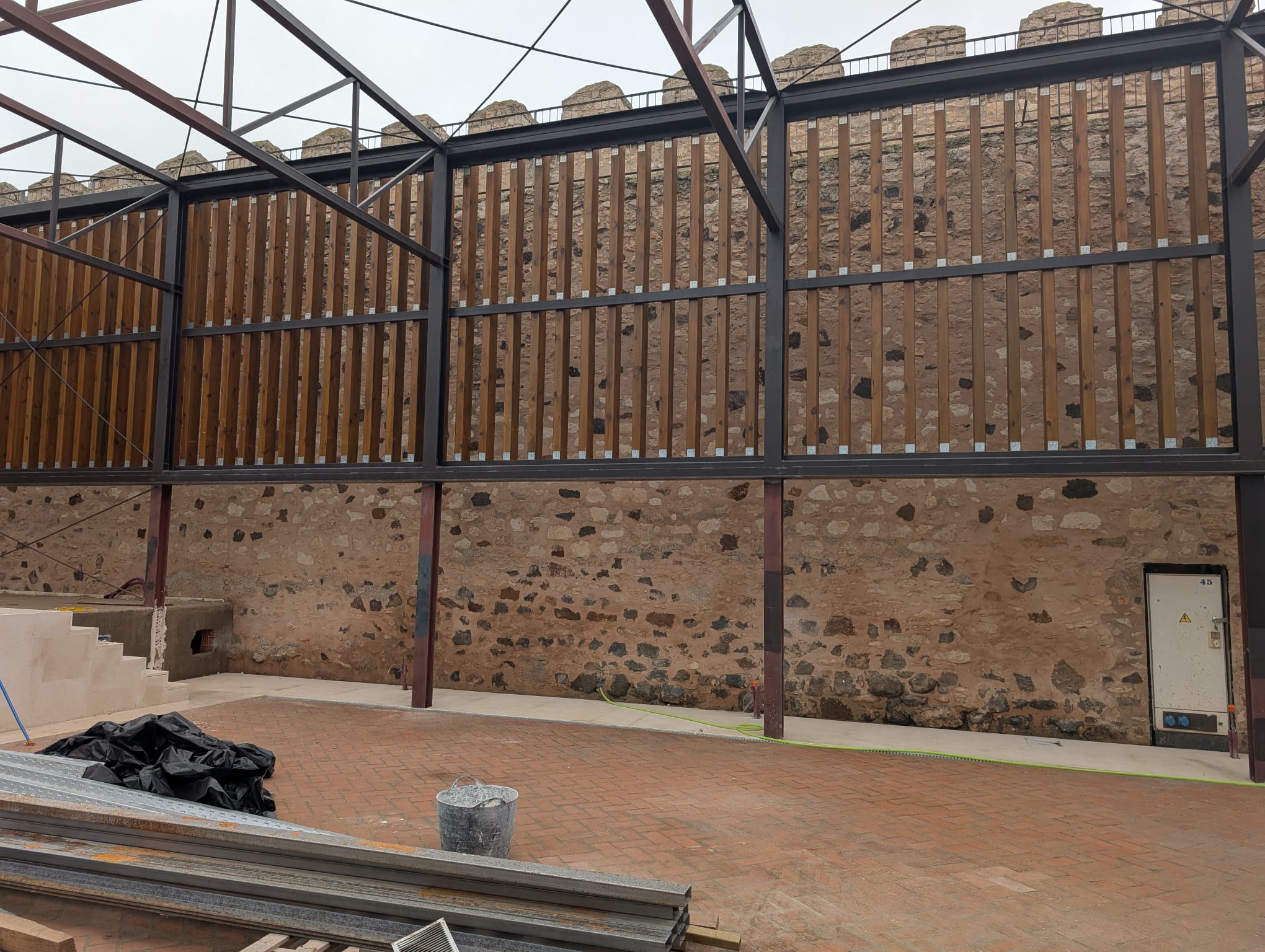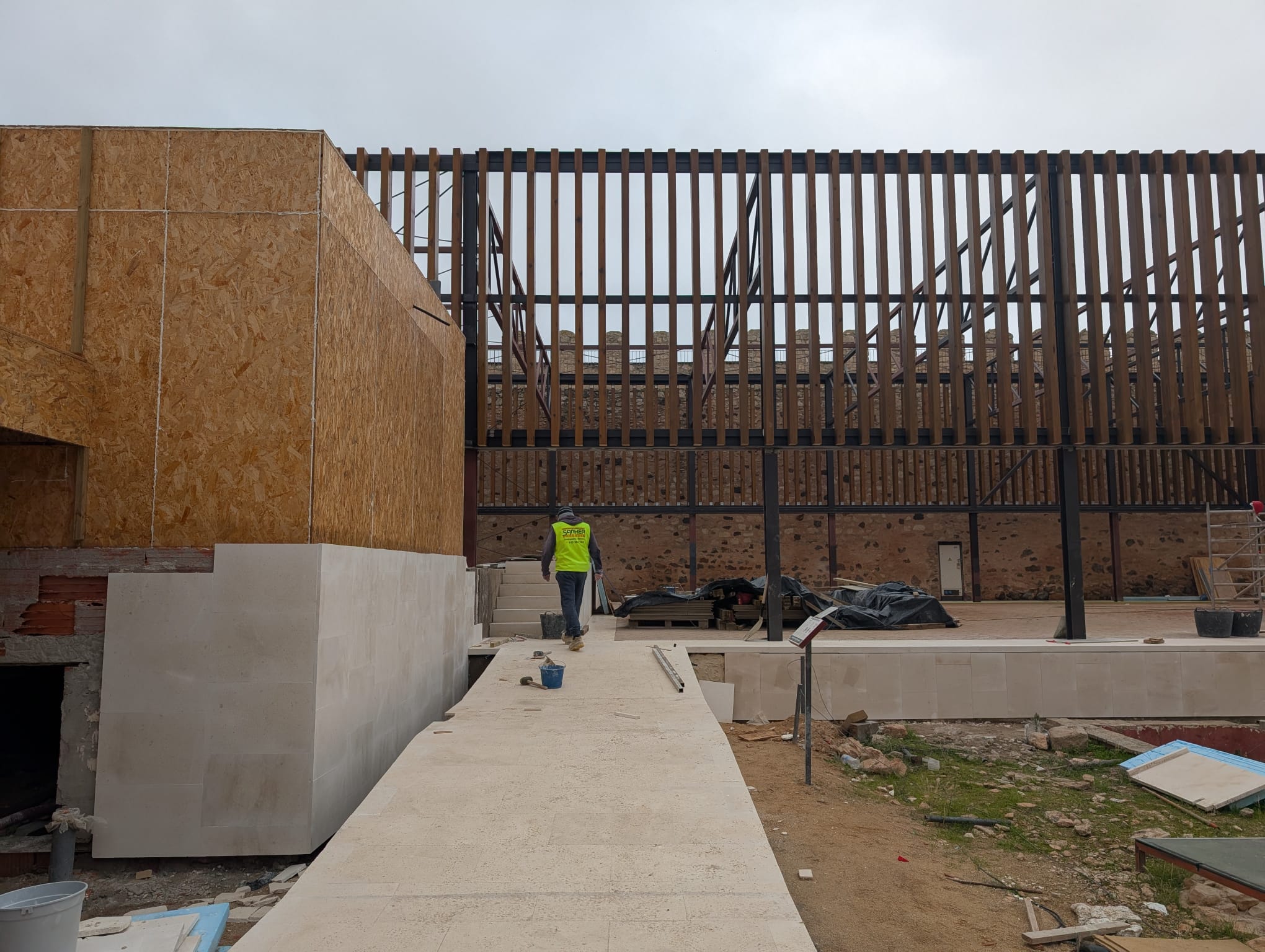ADAPTATION OF DOÑA BERENGUELA CASTLE
ADAPTATION OF THE OUTDOOR ENCLOSURE OF DOÑA BERENGUELA CASTLE FOR MULTIPLE USES
ADAPTATION OF THE OUTDOOR ENCLOSURE OF DOÑA BERENGUELA CASTLE FOR MULTIPLE USES
Spain
BOLAÑOS DE CALATRAVA, CIUDAD REAL
SPAIN
SPAIN
Early initiative
Yes
Yes
Yes
Yes
ERDF : European Regional Development Fund
{Empty}
No
13023: Bolaños de Calatrava (ES)
Main objective:
Transformation of an underused historical heritage property into a space open to citizens, intended to host cultural, educational and ethnographic activities, based on the criteria of inclusion, sustainability and design adapted to its use and respectful of the environment.
Recipients:
Citizens and groups in general, including neighborhood associations and immigrant population associations based in the municipality and region of Campo de Calatrava.
Specific objectives:
- Facilitate the adaptation of the space to different cultural and tourist manifestations: theatrical performances, concerts, medieval fairs, folklore performances by immigrant groups (mainly Bolivian and Ecuadorian), dramatized visits to the castle,...
- Promote the “Calatrava Destino” and “Calatrava Escena” brands, included in the development strategy of the Local Action Group of the Association for the Development of the Calatrava Countryside, which includes the municipality of Bolaños de Calatrava.
- Improve the environment using sustainable and environmentally friendly construction techniques and efficient lighting technologies that minimize the visual impact on the nighttime environment and illuminate the space without damaging its historical features.
Expected results:
-Improve the quality of the cultural offer of the municipality and the Campo de Calatrava region.
- Rehabilitate a space classified as an Asset of Cultural Interest, giving it alternative and diverse uses.
- Contribute to the challenge of fighting depopulation and fixing the existing population by providing quality heritage resources that can serve as a niche of economic activity for entrepreneurial activities in the tourism and services sector of the municipality and the region of Campo de Calatrava.
Transformation of an underused historical heritage property into a space open to citizens, intended to host cultural, educational and ethnographic activities, based on the criteria of inclusion, sustainability and design adapted to its use and respectful of the environment.
Recipients:
Citizens and groups in general, including neighborhood associations and immigrant population associations based in the municipality and region of Campo de Calatrava.
Specific objectives:
- Facilitate the adaptation of the space to different cultural and tourist manifestations: theatrical performances, concerts, medieval fairs, folklore performances by immigrant groups (mainly Bolivian and Ecuadorian), dramatized visits to the castle,...
- Promote the “Calatrava Destino” and “Calatrava Escena” brands, included in the development strategy of the Local Action Group of the Association for the Development of the Calatrava Countryside, which includes the municipality of Bolaños de Calatrava.
- Improve the environment using sustainable and environmentally friendly construction techniques and efficient lighting technologies that minimize the visual impact on the nighttime environment and illuminate the space without damaging its historical features.
Expected results:
-Improve the quality of the cultural offer of the municipality and the Campo de Calatrava region.
- Rehabilitate a space classified as an Asset of Cultural Interest, giving it alternative and diverse uses.
- Contribute to the challenge of fighting depopulation and fixing the existing population by providing quality heritage resources that can serve as a niche of economic activity for entrepreneurial activities in the tourism and services sector of the municipality and the region of Campo de Calatrava.
Transformation (of space)
Diversification (of cultural offer)
Participation (of neighbors, associations and population groups)
Sustainability (in the choice of materials and installations)
Adaptation (to the historical-artistic environment)
The execution of the project has been developed following sustainability criteria, both in the choice of materials and construction elements, and in the management of construction and construction waste.
Regarding waste management, the building has a reserve space for containers, located on the plot, as well as immediate storage spaces in toilets and dressing rooms, meeting the characteristics in terms of design and dimensions of DB-HS-2 Waste collection and evacuation, the project also complies with the provisions of Royal Decree 105/2008, which regulates the production and management of construction and demolition waste.
The lighting installations use efficient and environmentally friendly lighting technologies and equipment that minimize the visual impact on the nighttime environment without damaging heritage.
The project complies with the provisions of Law 21/2013, of December 9, on environmental evaluation and Law 4/2007, of March 8, on Environmental Evaluation of Castilla-La Mancha.
Regarding waste management, the building has a reserve space for containers, located on the plot, as well as immediate storage spaces in toilets and dressing rooms, meeting the characteristics in terms of design and dimensions of DB-HS-2 Waste collection and evacuation, the project also complies with the provisions of Royal Decree 105/2008, which regulates the production and management of construction and demolition waste.
The lighting installations use efficient and environmentally friendly lighting technologies and equipment that minimize the visual impact on the nighttime environment without damaging heritage.
The project complies with the provisions of Law 21/2013, of December 9, on environmental evaluation and Law 4/2007, of March 8, on Environmental Evaluation of Castilla-La Mancha.
The proposed piece is a simple contour coinciding with the paved multi-use area.
It constitutes the permanent support structure of the textile cover that reaches the height of the walkway level. The structure approaches, without touching, the south and west walls of the wall and will separate from the east and north walls. The separation strip with the west canvas incorporates a garden space with the wall as a visual background of the scenic space.
A light covering is proposed, with wooden slats on the upper part and open on the lower part, so that a transparency is produced along it that allows the wall to be understood as the delimiting element of the interior space of the castle, while at the same time the scale of the space is humanized. This arrangement allows the only closed spaces (toilets and dressing rooms) to be grouped into a set of volumes that does not interrupt the aforementioned transparency. The volume of the toilets is protected with a canvas of wooden slats similar to those of the volume of the stalls. At night the interior lighting of both slatted volumes would function as a light fan that would be projected onto the archaeological remains and onto the interior stone walls of the castle walls.
It constitutes the permanent support structure of the textile cover that reaches the height of the walkway level. The structure approaches, without touching, the south and west walls of the wall and will separate from the east and north walls. The separation strip with the west canvas incorporates a garden space with the wall as a visual background of the scenic space.
A light covering is proposed, with wooden slats on the upper part and open on the lower part, so that a transparency is produced along it that allows the wall to be understood as the delimiting element of the interior space of the castle, while at the same time the scale of the space is humanized. This arrangement allows the only closed spaces (toilets and dressing rooms) to be grouped into a set of volumes that does not interrupt the aforementioned transparency. The volume of the toilets is protected with a canvas of wooden slats similar to those of the volume of the stalls. At night the interior lighting of both slatted volumes would function as a light fan that would be projected onto the archaeological remains and onto the interior stone walls of the castle walls.
The project complies with Law 1/1994, of May 24, on accessibility and elimination of barriers in Castilla-La Mancha.
The main objective of the project is the transformation of a historical heritage property (Doña Berenguela's castle) into a space open to citizens, intended to host cultural, educational and ethnographic activities.
There is a commitment that municipal cultural associations contribute decisively to energizing the space, with special relevance to associations of immigrant groups.
It should be noted that the municipality of Bolaños de Calatrava hosts an immigrant population close to 20% of the total population. There are groups of nationalities, especially Ecuadorians and Bolivians, that have important roots in the municipality and that actively participate in municipal cultural life with exhibitions of their folklore and popular traditions.
Another integrating element is the Berenguela Festival that has been taking place for the last three years in the month of June, with the participation of local and provincial groups, associations and collectives.
The main objective of the project is the transformation of a historical heritage property (Doña Berenguela's castle) into a space open to citizens, intended to host cultural, educational and ethnographic activities.
There is a commitment that municipal cultural associations contribute decisively to energizing the space, with special relevance to associations of immigrant groups.
It should be noted that the municipality of Bolaños de Calatrava hosts an immigrant population close to 20% of the total population. There are groups of nationalities, especially Ecuadorians and Bolivians, that have important roots in the municipality and that actively participate in municipal cultural life with exhibitions of their folklore and popular traditions.
Another integrating element is the Berenguela Festival that has been taking place for the last three years in the month of June, with the participation of local and provincial groups, associations and collectives.
The adaptation of Doña Berenguela Castle in Bolaños de Calatrava as a cultural, educational and ethnographic space, under criteria of inclusion, sustainability and design that is adapted and respectful of the environment, can generate multiple benefits for the citizens and civil society of the municipality. The most relevant would be:
1.) Cultural and Educational Benefits:access to culture and education, promotion of local identity and pride, educational programs for all ages.
2.)Social and Inclusive Impact:promotion of citizen participation, and meeting and socialization space.
3.)Economic and Tourist Benefits:responsible tourist attraction, Job creation and entrepreneurship opportunities and revitalization of local commerce.
4.) Sustainability and respect for the environment:environmental and heritage education, green spaces and sustainable use, reduction of environmental impact.
5.) Impact on innovation and creativity: promotion of local creativity and platform for interdisciplinary collaboration.
The adaptation of Doña Berenguela Castle not only preserves the cultural and architectural heritage, but also generates a positive impact on the community from multiple dimensions: cultural, social, economic, environmental and creative. The key to maximizing these benefits lies in participatory planning and inclusive and sustainable space management.
1.) Cultural and Educational Benefits:access to culture and education, promotion of local identity and pride, educational programs for all ages.
2.)Social and Inclusive Impact:promotion of citizen participation, and meeting and socialization space.
3.)Economic and Tourist Benefits:responsible tourist attraction, Job creation and entrepreneurship opportunities and revitalization of local commerce.
4.) Sustainability and respect for the environment:environmental and heritage education, green spaces and sustainable use, reduction of environmental impact.
5.) Impact on innovation and creativity: promotion of local creativity and platform for interdisciplinary collaboration.
The adaptation of Doña Berenguela Castle not only preserves the cultural and architectural heritage, but also generates a positive impact on the community from multiple dimensions: cultural, social, economic, environmental and creative. The key to maximizing these benefits lies in participatory planning and inclusive and sustainable space management.
Participation of local, regional, national levels in the desing and implementation of the iniciative.The project initiative corresponds to the Bolaños de Calatrava City Council but it is managed within the framework of the Calatrava Cultural Park of the Association for the Development of the Calatrava Countryside, which includes the Bolaños de Calatrava City Council.
The project obtained the support of the Local Action Group of the Association for the Development of the Calatrava Countryside at its meeting on November 17, 2020.
In the Participatory Local Development Strategy 2023-2027 of Campo de Calatrava, it falls within Axis B (IDENTITY, CULTURE AND SUSTAINABLE TOURISM), in the Calatrava Scene and Calatrava Destino projects.
The project obtained the support of the Local Action Group of the Association for the Development of the Calatrava Countryside at its meeting on November 17, 2020.
In the Participatory Local Development Strategy 2023-2027 of Campo de Calatrava, it falls within Axis B (IDENTITY, CULTURE AND SUSTAINABLE TOURISM), in the Calatrava Scene and Calatrava Destino projects.
A project to transform Doña Berenguela Castle in Bolaños de Calatrava as a cultural, educational and ethnographic space, with a focus on inclusion and sustainability, involves multiple disciplines and fields of knowledge that interact in an interdisciplinary manner to guarantee the success of the project.
Disciplines or fields of knowledge involved:
-Architecture and heritage
-History and arqueology
-Education and pedagogy
-Ethnography and Anthropology
-Tourism and Cultural Management
-Sustainability and Environment
-Accessibility and Social Inclusion
-Technology and Digitalization
The success of the project depends on an interdisciplinary collaboration in which experts from each field work together:
Architects and heritage experts collaborate with historians and archaeologists to ensure that the restoration respects the historical authenticity of the castle.
Educators and pedagogues work with cultural agents and ethnographers to design cultural experiences that convey local history in meaningful ways.
Cultural managers and tourism experts coordinate with sustainability specialists to create an environmentally friendly management model.
Accessibility designers work alongside technologists to develop inclusive solutions in heritage interpretation.
The local community plays a key role in decision-making, ensuring that the space represents their values and identity.
In summary, this project is an example of how different disciplines can converge on a common purpose, integrating diverse knowledge to transform the castle into a living, accessible and sustainable space for the enjoyment of all generations.
Disciplines or fields of knowledge involved:
-Architecture and heritage
-History and arqueology
-Education and pedagogy
-Ethnography and Anthropology
-Tourism and Cultural Management
-Sustainability and Environment
-Accessibility and Social Inclusion
-Technology and Digitalization
The success of the project depends on an interdisciplinary collaboration in which experts from each field work together:
Architects and heritage experts collaborate with historians and archaeologists to ensure that the restoration respects the historical authenticity of the castle.
Educators and pedagogues work with cultural agents and ethnographers to design cultural experiences that convey local history in meaningful ways.
Cultural managers and tourism experts coordinate with sustainability specialists to create an environmentally friendly management model.
Accessibility designers work alongside technologists to develop inclusive solutions in heritage interpretation.
The local community plays a key role in decision-making, ensuring that the space represents their values and identity.
In summary, this project is an example of how different disciplines can converge on a common purpose, integrating diverse knowledge to transform the castle into a living, accessible and sustainable space for the enjoyment of all generations.
The innovative nature of the Doña Berenguela Castle transformation project in Bolaños de Calatrava, under inclusion and sustainability criteria, can cover several key aspects:
1.) Integrative cultural and educational approach: The conversion of the castle into a cultural and educational space not only preserves the history of the place, but also turns it into an active center of learning and dissemination of heritage.
2.)Social inclusion: Implementing an inclusive approach implies that the project is designed to be accessible to all types of people, regardless of their age, physical condition or social situation. This could include the physical accessibility of the space, activities and programs aimed at vulnerable groups.Furthermore, the creation of collaborative projects that allow social and cultural integration could be encouraged.
3.)Sustainability: The project incorporates sustainability principles both in the restoration and adaptation of the castle and in the long-term management of the space. This could involve using eco-friendly materials for restoration, implementing renewable energy (solar panels, for example), and encouraging environmental conservation practices. Sustainability can also be reflected in educational programs, promoting awareness of the environment and local heritage.
4.Use of new technologies: Integrating digital technologies for cultural and educational dissemination is another innovative aspect. The use of augmented or virtual reality, for example, could allow visitors to experience history in a more interactive way, or take digital guided tours in several languages, adapted to different needs (people with visual or hearing disabilities, etc.).
5.) Experience tourism and awareness: Create a tourist offer that is not limited to the traditional visit, but rather focuses on an experiential and educational experience that involves visitors in activities, workshops, historical representations and other events.
1.) Integrative cultural and educational approach: The conversion of the castle into a cultural and educational space not only preserves the history of the place, but also turns it into an active center of learning and dissemination of heritage.
2.)Social inclusion: Implementing an inclusive approach implies that the project is designed to be accessible to all types of people, regardless of their age, physical condition or social situation. This could include the physical accessibility of the space, activities and programs aimed at vulnerable groups.Furthermore, the creation of collaborative projects that allow social and cultural integration could be encouraged.
3.)Sustainability: The project incorporates sustainability principles both in the restoration and adaptation of the castle and in the long-term management of the space. This could involve using eco-friendly materials for restoration, implementing renewable energy (solar panels, for example), and encouraging environmental conservation practices. Sustainability can also be reflected in educational programs, promoting awareness of the environment and local heritage.
4.Use of new technologies: Integrating digital technologies for cultural and educational dissemination is another innovative aspect. The use of augmented or virtual reality, for example, could allow visitors to experience history in a more interactive way, or take digital guided tours in several languages, adapted to different needs (people with visual or hearing disabilities, etc.).
5.) Experience tourism and awareness: Create a tourist offer that is not limited to the traditional visit, but rather focuses on an experiential and educational experience that involves visitors in activities, workshops, historical representations and other events.
The methodology of a project to transform Doña Berenguela Castle based on:
1.) Diagnosis and preliminary analysisA comprehensive evaluation of the castle's infrastructure, architectural heritage, existing materials, environmental conditions, and accessibility is carried out.
2.) Participatory planning.Consultations and workshops with the community.Through meetings, surveys and participatory workshops, ideas and proposals are collected from citizens, local experts and interest groups.
3.) Comprehensive and sustainable design.The design must be respectful of the original architecture of the castle, but incorporating modern elements to ensure accessibility, safety and sustainability. The restoration must use ecological materials and energy-efficient technologies.Also, sccessible and inclusive design.
4.) Implementation with a sustainable approach. During the execution phase, sustainability criteria must be applied, using recycled materials, clean energy solutions and waste management systems. Also, development of inclusive activities.
5.) Continuous evaluation and participation
Impact evaluation: Throughout the entire process, periodic evaluations are carried out to ensure that the objectives are being achieved in terms of sustainability, social inclusion and heritage conservation. This includes reviewing resource use, user satisfaction, and impact on the local community.
Constant feedback: Communication channels are enabled to maintain a continuous relationship with the community and visitors, allowing actions to be adjusted according to their needs and opinions.
6.) Promotion and dissemination with events, exhibitions and educational activities.Use of technologies.
1.) Diagnosis and preliminary analysisA comprehensive evaluation of the castle's infrastructure, architectural heritage, existing materials, environmental conditions, and accessibility is carried out.
2.) Participatory planning.Consultations and workshops with the community.Through meetings, surveys and participatory workshops, ideas and proposals are collected from citizens, local experts and interest groups.
3.) Comprehensive and sustainable design.The design must be respectful of the original architecture of the castle, but incorporating modern elements to ensure accessibility, safety and sustainability. The restoration must use ecological materials and energy-efficient technologies.Also, sccessible and inclusive design.
4.) Implementation with a sustainable approach. During the execution phase, sustainability criteria must be applied, using recycled materials, clean energy solutions and waste management systems. Also, development of inclusive activities.
5.) Continuous evaluation and participation
Impact evaluation: Throughout the entire process, periodic evaluations are carried out to ensure that the objectives are being achieved in terms of sustainability, social inclusion and heritage conservation. This includes reviewing resource use, user satisfaction, and impact on the local community.
Constant feedback: Communication channels are enabled to maintain a continuous relationship with the community and visitors, allowing actions to be adjusted according to their needs and opinions.
6.) Promotion and dissemination with events, exhibitions and educational activities.Use of technologies.
1. Impact on the local community economic and social revitalization with the creation of a cultural, educational and tourist space in the castle can generate new jobs and attract both tourism and new commercial initiatives in the region. Also, the project can help reinforce the sense of belonging and pride of the local community, by highlighting its historical and cultural heritage. It is important the social inclusion because can improve the quality of life of varous groups in the community, such as people with disabilities or vulnerable groups, offering them access to culture, education and social integration.
2. Impact on other nearby locations and regions
The project could serve as a model for other towns in Castilla-La Mancha or similar regions that seek to revitalize their historical heritage through an inclusive and sustainable approach. The initiative can inspire similar projects in other castles, historic buildings or heritage spaces.
Inter-municipal cooperation: Collaboration between nearby municipalities can increase, as the success of the project could lead to joint initiatives on issues such as cultural tourism, heritage preservation and sustainable development. This could improve the cultural and tourist offer of the region.
3. Impact in the educational field.The castle converted into a cultural and educational center will directly influence the educational field, offering a platform for interactive learning about history, culture and local traditions.
4. Impact on tourism and culture at the regional and national level.Attracting sustainable tourists can position Bolaños de Calatrava as a leading cultural and tourist destination in the region.
5. Impact on the environmental context.The project's sustainable approach, which could include the use of renewable energy, recycled materials and efficient resource management.
6. Impact on social inclusion at a broader level.
2. Impact on other nearby locations and regions
The project could serve as a model for other towns in Castilla-La Mancha or similar regions that seek to revitalize their historical heritage through an inclusive and sustainable approach. The initiative can inspire similar projects in other castles, historic buildings or heritage spaces.
Inter-municipal cooperation: Collaboration between nearby municipalities can increase, as the success of the project could lead to joint initiatives on issues such as cultural tourism, heritage preservation and sustainable development. This could improve the cultural and tourist offer of the region.
3. Impact in the educational field.The castle converted into a cultural and educational center will directly influence the educational field, offering a platform for interactive learning about history, culture and local traditions.
4. Impact on tourism and culture at the regional and national level.Attracting sustainable tourists can position Bolaños de Calatrava as a leading cultural and tourist destination in the region.
5. Impact on the environmental context.The project's sustainable approach, which could include the use of renewable energy, recycled materials and efficient resource management.
6. Impact on social inclusion at a broader level.
1. Revitalization of local heritage with conservation of cultural heritage. The castle can become a symbol of the historical identity of Bolaños de Calatrava. Through its restoration and transformation, the preservation of a cultural asset of great value is ensured, which reinforces the community's bond with its history and traditions. Proper conservation can also open opportunities for residents.
2. Generation of local employment.
3. Sustainable tourism: Attracting responsible tourism.
4.Training and education.
5. Social inclusion.
6. Promotion of creativity and local art.
7. Strengthening social cohesion.
2. Generation of local employment.
3. Sustainable tourism: Attracting responsible tourism.
4.Training and education.
5. Social inclusion.
6. Promotion of creativity and local art.
7. Strengthening social cohesion.
A series of activities can be foreseen that will guide its development and implementation. These activities align with the values and principles of the NEB ensuring that the initiative is not only culturally enriching, but also accessible, inclusive, sustainable and participatory.
1.)Restoration and adaptation of physical space. The restoration of the castle will be carried out under principles of sustainability, using local, ecological and environmentally friendly materials. Universal accessibility will be ensured through the installation of ramps, elevators and improvements to health and safety infrastructure.Also, design will be made to ensure that all people, regardless of ability or age, can access and enjoy the castle and its activities.
2.) Creation of educational and cultural spaces.Areas dedicated to education about local history, ethnography and the region's heritage will be developed.
3.)Development of social inclusion programs. Specific programs will be created to promote the inclusion of people with disabilities, older people, immigrants and other vulnerable groups
4.)Promotion of sustainable and responsible tourism.Guided routes will be developed that connect the castle with other elements of cultural and natural interest in the region. These routes will focus on sustainability and environmental protection.
5.)Development of cultural activities and festivals.
The project values will be:
1.)Social inclusion and community participation
2.)Environmental and economic sustainability
3.)Wellbeing and accessibility
4.)natural and cultural environment
1.)Restoration and adaptation of physical space. The restoration of the castle will be carried out under principles of sustainability, using local, ecological and environmentally friendly materials. Universal accessibility will be ensured through the installation of ramps, elevators and improvements to health and safety infrastructure.Also, design will be made to ensure that all people, regardless of ability or age, can access and enjoy the castle and its activities.
2.) Creation of educational and cultural spaces.Areas dedicated to education about local history, ethnography and the region's heritage will be developed.
3.)Development of social inclusion programs. Specific programs will be created to promote the inclusion of people with disabilities, older people, immigrants and other vulnerable groups
4.)Promotion of sustainable and responsible tourism.Guided routes will be developed that connect the castle with other elements of cultural and natural interest in the region. These routes will focus on sustainability and environmental protection.
5.)Development of cultural activities and festivals.
The project values will be:
1.)Social inclusion and community participation
2.)Environmental and economic sustainability
3.)Wellbeing and accessibility
4.)natural and cultural environment

